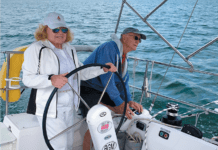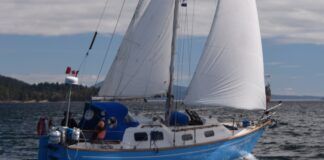Sailors – cruising sailors in particular – are famously thrifty. When each saved dollar translates to another mile voyaging, the incentive to save is pressing.
In the spirit of maritime thrift (if there isn’t such a term, there should be), Practical Sailor editors did a little research and decided to concoct our own homemade grease cleaner. Recipes for homemade degreasers abound, and most of them have two key ingredients mixed in water: a surfactant to loosen surface tension between the water and oil (dishwashing detergent will work), and a high-alkaline solution to loosen the grease (ammonia is the most common choice for this). Many recipes suggest boosting the cleaning power with hot water, no surprise since this is an element in nearly all commercial degreasing processes.
The recipe we settled on was one of several we found on www.tipnut.com: lemon-scented ammonia, hot water, and Dawn dishwashing liquid. We filled an empty liquid dish detergent bottle half full with household cleaning ammonia, then topped it off with hot water. We then added a few squirts of Dawn dishwashing detergent.
A half-gallon of lemon-scented ammonia set us back $1.89, the Dawn was borrowed from the galley. We didnt have a spray top like the degreasers in our test, but we could have bought one for less then the money we saved.
Practical Sailor matched the homemade remedy against the top two performers in the grease testing – Krud Kutter Degreaser/Stain Remover and Mary Kate Grease Away Engine Degreaser. Practical Sailor tried the trio of cleaners on a variety of greasy surfaces, ranging from windows, stoves, and grills, to our fiberglass test panels. The tester followed the same general procedure as he did for the degreaser test, using small clean rags and comparing the amount of grease each picked up.
In the first test, all three cleaners did a decent job of removing the thin layers of grease from smooth surfaces (windows and countertops). When it came to cleaning grills and other tough grease stains, the homemade cleaner also did a very good job – as good as Mary Kate Grease Away Engine Degreaser. However, it was obvious that Krud Kutter worked faster than both the Mary Kate and the homemade blend. The stuff works really well.
Bottom line:The ammonia-water-Dawn cleaner was effective (the ammonia was 3-cents per ounce) but was very difficult to work with due to the high ammonia content. If you can stand the eye- and throat-burning ammonia, go for it. If youve got a really tough job on your hands, Practical Sailors Best Choice is still the Krud Kutter.
To help you determine which cleaning methods and products are best for your lines as well as other specialty products that are worth adding to your cleaning arsenal, purchase and download Practical Sailor’s ebook Specialty Marine Cleaners today!
In it, youll find information on maintenance products for tasks above the waterline, cleaning sails and ropes, degreasing, reviving inflatable dinghies and fenders, and those that will suit the eco-conscious sailor.
To read even more about the cleaning and maintenance of all your boating surfaces, buy the entire three-part series for the price of two! Available for purchase and download is Practical Sailor’s ebook series, MARINE CLEANERS. This three volume set contains the ebooks GELCOAT MAINTENANCE AND RESTORATION, ESSENTIAL MARINE CLEANERS and SPECIALTY MARINE CLEANERS.
You’ll get one complete ebook FREE.





































